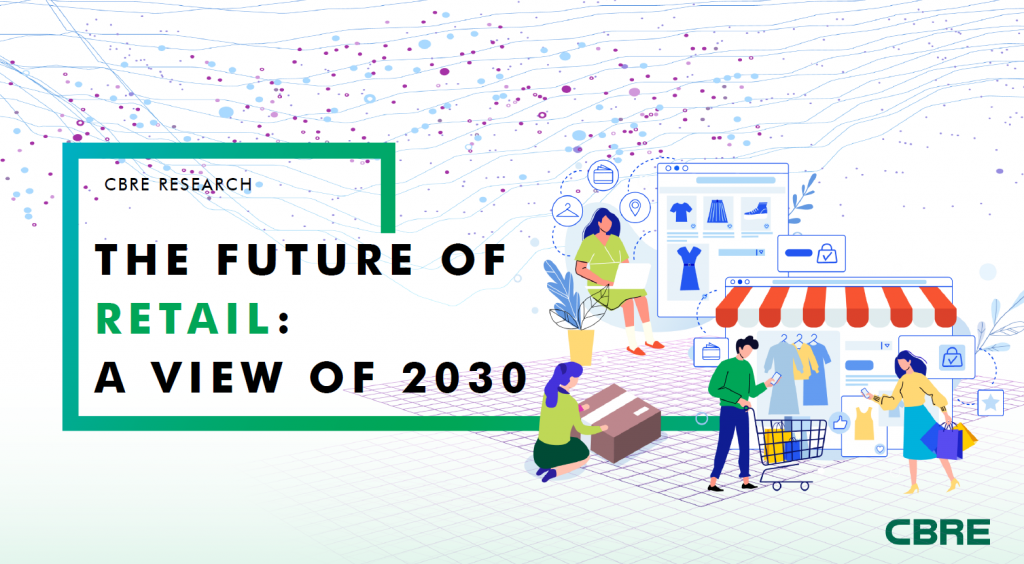(12 November 2020, Asia Pacific) The retail industry in Asia Pacific is poised for tremendous change over the next decade as the Covid-19 pandemic accelerates technological transformation, resulting in physical and digital platforms converging to meet consumer demand in terms of convenience, speed and cost, according to CBRE’s The Future of Retail – A View of 2030 report.

There are signs of turnaround emerging in Q3 this year. 96 percent of retailers indicated their stores have reopened although some are still subject to social distancing restrictions. The correction in retail sales continued to narrow in recent months. Specifically, retail sales in Australia, Japan and Mainland China returned to mild growth on a y-o-y basis in in August/September.
“In fact, this record breaking gross merchandise volume (GMV) of Double 11 Global Shopping Festival this year of US$116 billion1 proves the solid path to recovery of the Mainland China domestic consumption,” said Dr. Henry Chin, CBRE’s Global Head of Investor Thought Leadership and Head of Research for Asia Pacific.
Retailer sentiment is also turning more positive towards 2021. “From our recent APAC Retail flash survey conducted in October 2020, 49 percent of respondents display more upbeat sentiment towards opening new stores in the next year. Close to 50 percent expect that store opening and expansion plans will proceed.” Vivek Kaul, CBRE Head of Retail for Asia commented. Retailers will still evaluate the options of closing non-performing stores while looking for opportunities to tape on prime space and weaker leasing market condition according to CBRE Asia Pacific Retailer Flash Survey (Sept).
Key Findings of CBRE Retail Flash Survey
• Reopening stores: 96 percent of stores have reopened although some are still subject to social distancing restrictions
• Regaining business: 66 percent expect it will take six months or more for sales to return to pre-pandemic levels
• Resuming expansion: 49 percent expect to proceed with New store openings and expansion plans in 2021
• Restacking space: 57 percent plan to increase space in stores to handle online orders
• Revisiting leases: 72 percent will insert or expand the coverage of force majeure clauses when signing new leases
Retail is here to stay
The Pandemic has accelerated the transformation in the retail industry, but retail is here to stay.
The industry has been undergoing many structural changes but retailers and landlords in the region have been and will continue to be adoptive. CBRE expect technology will facilitate future changes and transformation of retail but it will shift from retail disruptor to enabler. Consumer analytics, in store automation and mobile payment have been identified as the most important tech innovations in the next decade. About 75 percent of survey respondents view technology as an enabler rather than a disruptor for the retail sector.
Most landlords said they are well prepared for further technological advancement, and some have assembled their own innovation teams or are collaborating with start-ups to develop retail technologies. As a result of the pandemic, rising labour costs and a shortage of experienced workers, many retailers are exploring ways to reduce human-to-human contact. About 71 percent of occupier respondents ranked in-store automation among the technologies they expect to have the biggest impact on the retail sector in 2030.
Brick-and-mortar retailers are harnessing technology to analyse consumer spending and behaviour such as browsing history, purchase records, demographics and spending patterns to tailor their marketing efforts accordingly, an advantage that e-commerce platforms have with the wealth of data collected through online shopping. Amid the presence of Covid-19 and proliferation of the smartphone, many consumers have opted for contactless payment, a trend that survey respondents expect to accelerate over the next decade.
By 2030, CBRE expects to see much closer collaboration between occupiers and landlords on data analytics. Psychographic consumer marketing – which involves a thorough analysis of consumers’ personalities, values and beliefs – is expected to be adopted widely by that time.
The future consumers
The five generations of consumers by 2030 including the Generation Z – those born after 1997 – who will emerge as a powerful source of retail spending, as well as the post-Gen Z, or those born after 2014. Our research indicates that Gen Z care more about brand values, personalisation and sustainability relative to other age groups. Occupiers and landlords will need to engage these shoppers by providing goods and services catering to the lifestyle and values they exemplify. Physical stores will transform to serve more as a platform for businesses to engage consumers and amplify their brand, especially through experience-oriented spaces, rather than as a point of sale.
“Retailers continue to invest in enhancing in-store experience and support online orders. We therefore see the increasing allocation of space for next-generation fitting rooms, product testing zones and click-and-collect counters.” Mr Kaul continues, “less space will be allocated to areas like in-store inventory storage and check-out counters, since they have a minimal positive impact on consumer satisfaction.”
The Future for Landlords: Rethinking strategies and redefining performance
“The retail industry will undergo significant changes in the next decade and landlords need to be quick and adaptive to stay successful, as the retail space evolves and new technologies are adopted, store designs will need to be overhauled to engage and serve the demands of the next generation of shoppers,” Mr Chin commented.
Landlords will need to rethink their strategies and redefine performance metrics. Consumers’ visits to shopping centres are already becoming more purpose driven, with many shoppers conducting research and online purchases well in advance. Landlords will therefore have to provide more features to attract and impress the public. This can be achieved by creating compelling visual stimuli.
Thematic design will guide the refreshed layout of shopping centres and retail stores. Artistic and cultural elements will be increasingly incorporated into properties and will eventually operate as both amenities and components of the tenant mix.
By 2030, occupiers and landlords may place a greater emphasis on a property’s marketing value and social media reach than sales turnover when it comes to setting rents. New metrics are likely to include foot traffic generation, in mall engagement and social media performance.
While rental income will continue to be landlords’ major income stream, property owners will increasingly explore other sources of revenue generation such as on demand facilities, in mall advertising and sponsorship.
“Phygital” Retail, a combination of the physical and digital world of retail to cater to consumer demand for convenience, speed and cost is set to be growing in permanence. Collaboration, innovation and differentiation will be the keys to success in the future of retail. Retail is here to stay.












